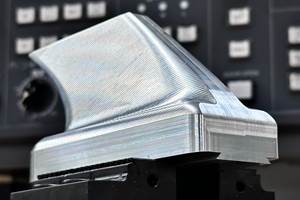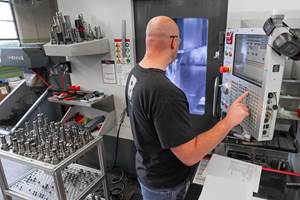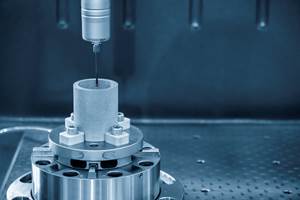Buying an HMC: Tooling and Workholding Considerations
Is it time to move up to an HMC? Let’s look at tooling- and workholding-related concerns that those interested in acquiring an HMC will want to keep in mind.
Share





This blog post is adapted from an article by Barry Rogers which appeared in the May edition of the Machine/Shop print supplement to 91ÊÓƵÍøÕ¾ÎÛ.
In the first part of this blog post series on buying a horizontal machining center, we covered some of the structural, application and design factors that differentiate HMCs from vertical machines. In this post, let’s look at tooling- and workholding-related concerns that those interested in acquiring an HMC will want to keep in mind.
Indexing Table or Full Fourth Axis
All modern HMCs are built with indexing tables and are considered four-axis machines. Assuming you’ll be using a tombstone with parts on each side (which is how almost all HMCs are set up in machine shops), you can perform operations not only across the front, but also from the right and left sides of the part. For example, a valve body with holes on the sides can be machined in one setup.
Basic HMC tables are indexable, meaning that the table can turn and lock in 1-degree increments only. The part can be turned, say 20 degrees, cut at that angle, or perform other operations such as facing a surface at an odd angle, milling a pocket, or drilling/tapping a hole. Odd angles that require complex setups and fixtures on a VMC become easy to program when machined on an HMC.
HMCs can also be ordered with a “full fourth axis” that will move to any angle, say 11.5 degrees, under programmed command and enable cutting while the table rotates simultaneously. Indexing tables are not capable of cutting odd angles or cutting while the table rotates. In fact, indexing tables have another disadvantage compared to a full fourth axis in that indexing tables are considerably slower. To index the table, the spindle must first retract the cutting tool; the table must then unclamp, rotate to the desired angle or location, then re-clamp. These steps lengthen the machining cycle. However, full-fourth-axis tables also have a disadvantage. They’re expensive. The deciding factor is the required process.
Automatic Toolchanger
A standard feature of most HMCs is a 40- or 60-pocket automatic toolchanger (ATC). The simplest type of ATC has a dedicated pocket for each tool. Changing tools will take longer with this type of ATC than other types because it must put the tool back into the same pocket after each use. In contrast, a random-access toolchanger, often called a matrix magazine, can retrieve a tool and return it to any pocket, because the controller keeps track of each tool location. Tool changes are quicker.
Some workpieces may require more than 60 tools to complete the job. Here’s when much thought and planning are necessary prior to purchasing a machine. To determine required toolchanger capacity, find tooling commonalities across the full range of workpieces intended for the HMC. Use standardized tooling to make best use of all available tool pockets in any ATC. Redundant or sister tooling may also be added to help keep the spindle running for longer periods.
Automatic Pallet Changers
Moveable pallets that sit on the indexing table or fourth axis can be used to secure the associated fixtures and parts for machining. These pallets can be moved in and out of the workzone with an automatic pallet changer (APC). The APC is essentially a rotating carrier with two sides separated by a panel. The pallet is rotated to face the machining zone and lifted onto the table so the parts it holds can be machined, while the pallet on the other side of the panel can be handled outside the workzone. By continuously exchanging pallets, the APC can keep the HMC running with little time between pallet changes. Ninety percent of all horizontals come with an APC
Tombstones are upright fixture blocks with two or more sides onto which parts can be mounted for machining. They are also known as pedestal-type fixtures, tooling towers or tooling columns. These fixture blocks can be configured with two, three, four or six sides. The basic idea of a tombstone is to hold multiple parts per side. Typically, tombstones are made from aluminum or cast iron, and have bolt holes for attaching fixtures and clamps to hold the parts. The tombstone can be mounted on a moveable pallet to be shuttled in and out of the machine.
Single-sided angle plates can also be mounted on an HMC, with or without the use of a tombstone, to machine parts made from flat plate.
Fixturing
With an HMC, you have to be more creative when it comes to fixture designs. Fixtures may require more sophistication than those for a VMC, depending on part size. While it’s often easy to get by with using vises on a VMC, vises are less useful on a horizontal. Common tooling items used on HMC fixturing include edge clamps, toe clamps and wedge clamps. While fixturing on an HMC might seem complicated, it also provides considerable flexibility. HMCs can use hydraulic or pneumatic fixturing. Some machines have the option to plumb hydraulic or pneumatic lines through the pallet which can then be incorporated into the fixturing. M codes are used in the CNC program to apply clamping pressure into fixtures in the machining zone. Although you can do the same on a VMC, it’s more convenient on an HMC, because the pallet can be shuttled to the unload station while the clamps are still engaged. Hydraulic and pneumatic lines are usually fixed on a VMC, but on a horizontal, the lines are usually integrated in the pallet. This feature gives you the ability to use multiple hydraulic or pneumatic fixtures across multiple pallets without having to remove and replace hydraulic lines or fittings.
Pallet Pools
Pallet pools enable more than two pallets to be used for continuous operation. Without a pallet pool, there are only two pallets and they must run one after the other. A pallet pool interfaces directly to the APC, enabling a pallet to run in any order you decide. For example, if you have four different jobs lined up on the machine and one job runs out of material, production of the other three can continue.
Typically, pallet pools consist of six or more pallets, making around-the-clock, lights-out operation possible. Even if you buy an HMC with no intention of running all night, you still gain savings by automatic loading and unloading without interrupting the spindle of the machine. The uptime created by this method accounts for increased spindle utilization, which can be as high as 85 percent.
Compare machine specs from thousands of horizontal machining centers for free at .
Find more insights about acquiring a new machining center by visiting the Techspex Knowledge Center, “.”
Related Content
Custom Workholding Principles to Live By
Workholding solutions can take on infinite forms and all would be correct to some degree. Follow these tips to help optimize custom workholding solutions.
Read MoreMedical Shop Performs Lights-Out Production in Five-Axes
Moving to five-axis machining enabled this shop to dramatically reduce setup time and increase lights-out capacity, but success relied on the right combination of workholding and automation.
Read MoreFixtureworks Pneumatic Clamp Fasteners Reduce Setup Time
The product lineup includes ball-lock pneumatic fasteners, ID holding, pin holding single- and double-acting pneumatic clamping fasteners.
Read MoreParts and Programs: Setup for Success
Tips for program and work setups that can simplify adjustments and troubleshooting.
Read MoreRead Next
Last Chance! 2025 Top Shops Benchmarking Survey Still Open Through April 30
Don’t miss out! 91ÊÓƵÍøÕ¾ÎÛ's Top Shops Benchmarking Survey is still open — but not for long. This is your last chance to a receive free, customized benchmarking report that includes actionable feedback across several shopfloor and business metrics.
Read MoreMachine Shop MBA
Making Chips and 91ÊÓƵÍøÕ¾ÎÛ are teaming up for a new podcast series called Machine Shop MBA—designed to help manufacturers measure their success against the industry’s best. Through the lens of the Top Shops benchmarking program, the series explores the KPIs that set high-performing shops apart, from machine utilization and first-pass yield to employee engagement and revenue per employee.
Read MoreAMRs Are Moving Into Manufacturing: 4 Considerations for Implementation
AMRs can provide a flexible, easy-to-use automation platform so long as manufacturers choose a suitable task and prepare their facilities.
Read More





















